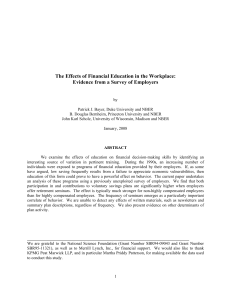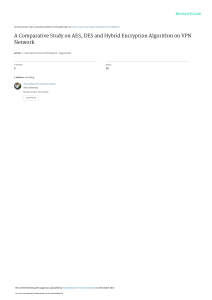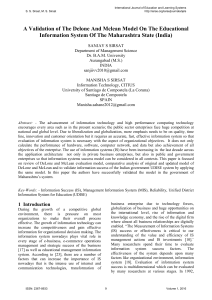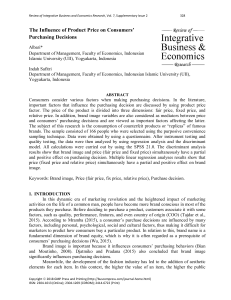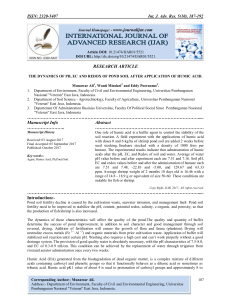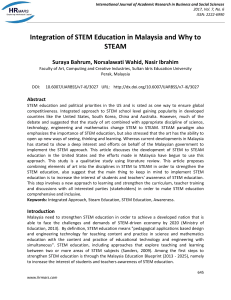Uploaded by
edison.leang08
Employee Benefits and Productivity: Structural Equations Approach
advertisement
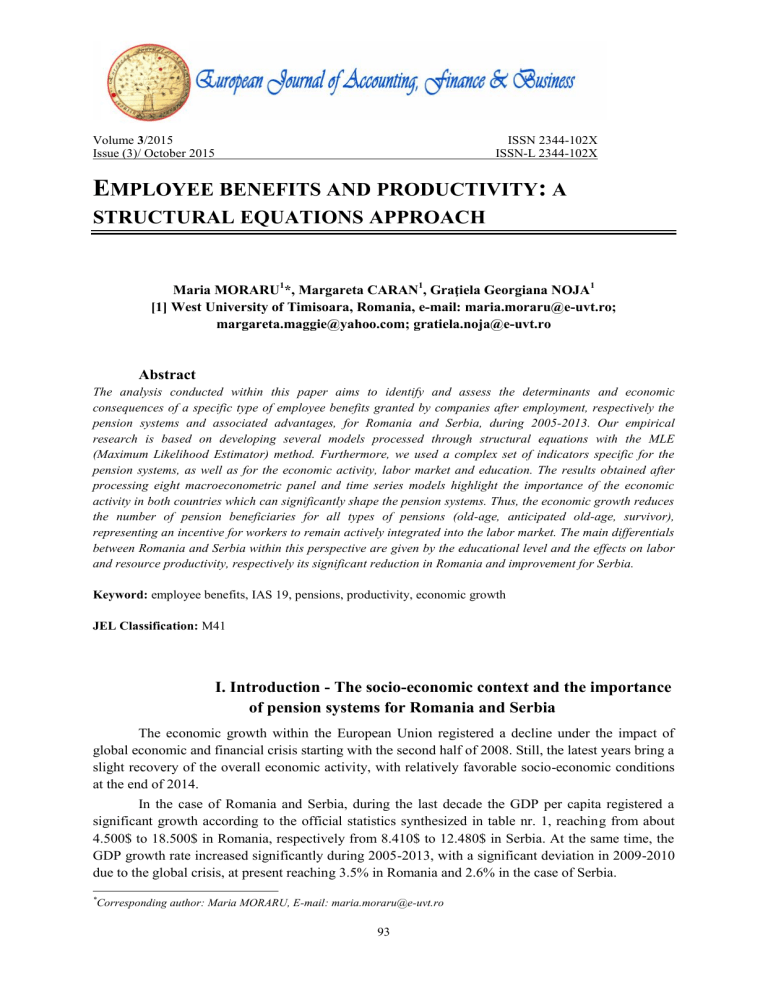
Volume 3/2015 Issue (3)/ October 2015 ISSN 2344-102X ISSN-L 2344-102X EMPLOYEE BENEFITS AND PRODUCTIVITY: A STRUCTURAL EQUATIONS APPROACH Maria MORARU1*, Margareta CARAN1, Graţiela Georgiana NOJA1 [1] West University of Timisoara, Romania, e-mail: [email protected]; [email protected]; [email protected] Abstract The analysis conducted within this paper aims to identify and assess the determinants and economic consequences of a specific type of employee benefits granted by companies after employment, respectively the pension systems and associated advantages, for Romania and Serbia, during 2005-2013. Our empirical research is based on developing several models processed through structural equations with the MLE (Maximum Likelihood Estimator) method. Furthermore, we used a complex set of indicators specific for the pension systems, as well as for the economic activity, labor market and education. The results obtained after processing eight macroeconometric panel and time series models highlight the importance of the economic activity in both countries which can significantly shape the pension systems. Thus, the economic growth reduces the number of pension beneficiaries for all types of pensions (old-age, anticipated old-age, survivor), representing an incentive for workers to remain actively integrated into the labor market. The main differentials between Romania and Serbia within this perspective are given by the educational level and the effects on labor and resource productivity, respectively its significant reduction in Romania and improvement for Serbia. Keyword: employee benefits, IAS 19, pensions, productivity, economic growth JEL Classification: M41 I. Introduction - The socio-economic context and the importance of pension systems for Romania and Serbia The economic growth within the European Union registered a decline under the impact of global economic and financial crisis starting with the second half of 2008. Still, the latest years bring a slight recovery of the overall economic activity, with relatively favorable socio-economic conditions at the end of 2014. In the case of Romania and Serbia, during the last decade the GDP per capita registered a significant growth according to the official statistics synthesized in table nr. 1, reaching from about 4.500$ to 18.500$ in Romania, respectively from 8.410$ to 12.480$ in Serbia. At the same time, the GDP growth rate increased significantly during 2005-2013, with a significant deviation in 2009-2010 due to the global crisis, at present reaching 3.5% in Romania and 2.6% in the case of Serbia. * Corresponding author: Maria MORARU, E-mail: [email protected] 93 Volume 3/2015 Issue (3)/ October 2015 ISSN 2344-102X ISSN-L 2344-102X Life expectancy at birth and the infant mortality rate represent some of the main indicators generally used in socio-economic analyses, being indicators of social development, with increased demographic characteristics. Tabel 1. Socio-economic and demographic indicators for Romania and Serbia, 2005-2013 2005 2006 2007 2008 2009 2010 2011 2012 2013 21634371 21587666 21546873 21513622 21480401 21438001 21384832 20076727 19963581 GDP per capita 4572 5681 7856 9498 7651 7670 8874 17700 18410 GDP (mil. US$) 98913 122641 169282 204335 164345 164435 189775 169396 189638 4.17 7.90 6.00 7.93 -6.58 -1.65 2.45 0.35 3.49 71.88 72.16 72.57 72.57 73.31 73.46 74.51 74.56 75.12 Romania Population GDP growth rate (%) Life expectancy at birth Serbia Population 7440769 7411569 7381579 7350221 7320807 7291436 7258745 7199077 7163976 GDP per capita 8410 9300 9890 11200 10860 11160 11550 12440 12480 GDP (mil. US$) 25234 29221 38952 47760 40147 38423 45819 40791 45519 5.40 3.60 5.40 3.80 -3.50 0.95 2.00 -1.01 2.6 72.63 73.16 73.38 73.64 73.69 73.94 74.59 75.23 75.38 GDP growth rate (%) Life expectancy at birth In Romania and Serbia, the living standards have increased during 2005-2013, as a result of the economic growth and GDP per capita improvements. Thus, life expectancy at birth increased significantly from an average of 71.3 (Romania) and 72.4 (Serbia) to about 75 in both countries. Figure 1. Employment density by districts in Romania and Serbia (employees per km2), 2013 Source: own process based on Eurostat data Nevertheless, the registered performances aren’t extremely important due to the fact that this increasing trend of Romanian employees has had a slow evolution, even though the economic growth was significant during the same period. Thus, employment density as number of employees per km2 94 Volume 3/2015 Issue (3)/ October 2015 ISSN 2344-102X ISSN-L 2344-102X for the districts of Romania and Serbia highlight an agglomeration around the capital city as the main economic pole of Romania, being extremely high in the south-east area of the country, respectively in the center and south-east of Serbia. Taking into consideration all these socio-economic aspects, we focus our attention on pension systems in Romania and Serbia, because pensions are one of the most important post-employment benefits granted by companies, which can be an incentive for workers to increase their productivity and the firm’s overall performance, leading to economic growth and welfare. In Romania, according to official data provided by the National House of Public Pensions, in December 2014 there were 4692711 pensioners, of which 3360361 were old-age pension beneficiaries, 21062 had an anticipated pension, 91089 had a partial anticipated pension, 686619 were disability pension beneficiaries and 532943 were survivor pensioners. At the same time, 637 people received social help of which 70% were females and 3675 people were comprised in a special category of invalidity and war widower’s pension. Serbia registered in 2013 a total number of 1.74 million pension beneficiaries, most of which were women (about 970000). The evolution of the total number of pensioners during 2005-2013 in Serbia was relatively stable, with an intensified increasing tendency in the last part of the period, respectively in 2012 and 2013. II. Literature review The adopted measures for stimulating the employees, depending on the possibility of not requiring high costs for the employer, will determine a direct and positive effect over the agent’s situation.(Maria Moraru, R. Blidișel, D. Știrbu, 2008, p.1450) Employee benefits are regulated by the International Accounting Standard – IAS 19 with the general objective to define its accounting and to present information concerning these types of advantages. Therefore, the IAS 19 recommends a company to present: (i) a liability, when an employee has performed a specific service for which he will be paid under the form of various benefits in the future, respectively (ii) an expense, when the economic agent benefits from the work and service provided by an employee in exchange of associated advantages. The International Accounting Standard – IAS 19 – Employee benefits, describes the main types of advantages granted by companies to their workers, including: (i) short-term benefits: such as salaries, weekly remunerations, social security contributions, paid annual leave, paid sick leave, bonuses, as well as other non-financial advantages, like medical assistance, cars and other goods or services given for free or subsidized; (ii) post-employment benefits: pensions, other retirement advantages or post-employment medical assistance; (iii) other long-term benefits, including long-service leave and other long-service advantages, disability benefits, bonuses, profit-sharing; (iv) termination benefits. IAS 26: “Accounting and reporting the pension plans” stands for accounting and reporting the operations that are being carried all throughout a pension plan in relationship with all of its participants, considered as a group, and it is applied regardless to a pension plan (that may or may not 95 Volume 3/2015 Issue (3)/ October 2015 ISSN 2344-102X ISSN-L 2344-102X be a distinct judicial entity, that may or may not be administrated, that contains contributions and out of which the pensions are being paid) being created and regardless to the existence of administrators. Pensions represent the employees’ benefits that are to be paid after terminating the employment contract. The pension plans represent contracts through which the enterprise grants its employees benefits, upon or after terminating their employment contracts (as an annual income or as an anticipated payment), when this kind of benefits or the owner’s contribution can be determined or estimated in advance by consulting certain documents or out of the enterprise’s experience. One of the main research questions found in the economic literature concerning pensions refers to the employers’ motivation to compensate their employees through pensions. Several studies explored pension theories, both through demand and offer perspectives. Demand pension theories have as main hypothesis the assumption that employers are indifferent to paying wages in cash or making contributions to a pension fund; thus, pensions are ensured in order to satisfy the employees demand to a specific savings system for retirement. A reduction of general and income taxes represent an essential reason for employees to prefer saving for retirement. As a result, rewarding employees with credible promises concerning future pension benefits and not through equivalent bonuses payed in cash can generate important tax reductions, especially in the case of employees with high wages. Another theory based on demand highlights the fact that pensions are an insurance policy against a large number of specific risks to retirement (Dorsey et al., 1998, p. 3). One such risk is related to the fact that pensioners can live longer than expected on average, so their savings for retirement period can significantly diminish or even disappear. Market solution for such risk is the annuities or payment of a fixed amount during a pensioner's lifetime. However, many problems arise from adverse selection, when annuities are acquired later in life because older people with health problems may refuse to purchase them. Pensions effectively resolve this problem by requiring workers to buy an annuity when they accept a job, thus participating in the pension scheme. Other theories pension centered on the demand side highlight the fact that economies of scale in managing private pensions allow workers to earn higher incomes (Mitchell and Moore, 1998), and that the unions prefer retirement schemes as they benefit members that are older (Freeman, 1985). However, demand-based pensions theories do not address the issue of retirement incentives created. The perspective focused on offer claims that incentives specific to pensions increase workers’ productivity and reduce labor costs. Internal theories of labor market suggest some mechanisms through which pensions could lead and promote productivity. Threat bought by the possibility of losing pension benefits may discourage intentions of not working, reducing significantly the costs associated to efforts of employees monitoring. III. Methodology and data Our empirical analysis performed in order to assess the pension systems in Romania and Serbia has a double objective: (i) first, to highlight the shaping factors of pension systems for the two countries considered and (ii) second, to assess the impact of post-employment benefits such as pensions on economic activity and productivity. 96 Volume 3/2015 Issue (3)/ October 2015 ISSN 2344-102X ISSN-L 2344-102X The main research limit refers to the lack of detailed long series data for pension indicators, mainly for Serbia. Therefore, in order to complete the database necessary for processing the econometric models, in the initial phase of the research we proceeded to data interpolation and extrapolation for the pension indicators in Serbia, thus completing the 2005-2013 period. The macroeconometric analysis focuses on highlighting the resemblances and discrepancies between the two countries regarding the shaping factors and economic consequences of pension systems. Thus, the models were designed based on structural equations, both in panel and individually, using data for a variety of indicators for pensions (PBT = pension beneficiaries total), the overall economic activity (PIBtot = total GDP), employment/ unemployment (RO/RS), wages (VN), education (EDtert = tertiary education) and productivity (Prod_res). The general model designed for employee benefits and pension system analysis in Romania and Serbia based on structural equations is presented in figure 2. Log_PIBtot 1 2 Log_PBT Log_Prod_res Log_RS Log_VN Log_EDtert Figure 2. The general model designed for employee benefits and pension system analysis in Romania and Serbia based on structural equations Source: own process in Stata 12 IV. Results and discussions In order to highlight the shaping factors of pension systems in Romania and Serbia, as well as the economic impact on labor and resource productivity, we developed a set of eight macroeconometric models based on structural equations, processed through the MLE method of estimation, with Stata 12. The results obtained point out a very high level of statistical significance for estimated coefficients, mostly at 0.1%, thus allowing a proper and valid interpretation. We can observe that the economic activity, macroeconomic stability, the wage level and education represent the main shaping factors of pension systems in Romania and Serbia. More precisely, an increase in total GDP by 1% induces a decrease in the total number of pension beneficiaries by 0.105% (model 3) in Romania and by 0.456 (model 3) in the case of Serbia. Therefore, we appreciate that an improvement of living 97 Volume 3/2015 Issue (3)/ October 2015 ISSN 2344-102X ISSN-L 2344-102X standards for population reflected through an increase in total and per capita GDP may represent an incentive for workers to remain actively integrated into the labor market, thus reducing the will to early retirement and the total number of pensioners. At the same time, persons with secondary education seem to be more oriented to retirement, while an increase in education towards the tertiary level induce only a very small increase of pensioners in Romania and a decrease in Serbia, one of the main reasons for this being better working conditions and higher wages, important incentives to remain active within the labor market. However, imbalances in the labor market in the two countries as evidenced by high unemployment rates induce changes also at the level of pensions, rising unemployment leading to reduced number of pensioners (according to Model 6 a 1% increase in unemployment induces a decrease of 0.756 % of total number of pensioners). At the same time, increasing employment may create the necessary conditions for the withdrawal of employees among the workforce to retirement. Moreover, post-employment benefits as pensions granted to employees are significant incentives for companies that generate an increase in productivity and resources (approximately 0.80% according to estimates). Analyzing individual modelers factors of the pension system in Romania, we can see that the growth of total GDP and per capita reduces the overall number of pensioners in all categories. Thus, economic growth and improve living standards for the population, in conjunction with improved working conditions and wages, is important motivations for employees to remain active in the labor market. Also, the educational level of the population has a major role in shaping the number of pensioners in Romania, people with primary and secondary education is oriented towards withdrawal from workforce to retirement. However, the results of the impact on pension benefits granted in the form of resource productivity in Romania stresses that they do not lead to increased productivity, contrary to its significant reduction (by 3384% overall categories of pensions). For Serbia, the main factors of the pension system modelers identified by the results are also the economic activity, labor market performance and educational level. In this case, however, improving the education from primary to secondary causes significant reduction in the number of pensioners, both overall and among the beneficiaries of old age pension. Thus, regardless of the educational level, employees in Serbia seem to be more oriented towards remaining active on the labor market. This contrasts strongly with the elements identified in the Romanian case and the panel, explained above. Unlike Romania, Serbia employees seem to consider pensions as major advantages and incentives that lead to a significant increase in resource productivity (to 2.168% according to the results). Concluding remarks Our econometric modeling perspective uses structural equations for the analysis of postemployment benefits such as pensions in the case of Romania and Serbia. Multinational companies granted numerous benefits for their employees, for benefits such as healthcare, the Post-employment benefits such as plans and pension systems, but also to benefits during the leave, in support of employees' families, for career and professional development in 98 Volume 3/2015 Issue (3)/ October 2015 ISSN 2344-102X ISSN-L 2344-102X financial compensation and other benefits. This wide range of benefits contribute , according to the economic theory, on the growth in labor productivity, with significant positive effects on national economic growth and development over the long term. The comparative analysis of benefits granted by the companies employees in Romania and Serbia in recent years highlights the importance given to retirement benefits, the sustainability of this system and legislative measures to ensure transparency and facilitate change how to index pensions. The results of the processing of the models developed for analyzing the economic impact of pension systems in Romania and Serbia conforms that the elements of the literature, shows that the postemployment benefits to employees, including those in the form of pensions, are important and may lead to the increase of productivity and income, and improve the standard of living and the level of education. Therefore the results of the eight models were processed separately for Romania and Serbia, and highlight the importance of the economic activity in the two countries , that can significantly modify the pension systems,the economic growth ,with a reduction in the number of pensioners ,overall categories of pension. The essential differences are given by the education level and the labor productivity implications and resources (its significant reduction in the case of Romania and significant growth in the case of Serbia). References 1. Bender Keith (2009), „How are pension integration and pension benefits related?”, The Quarterly Review of Economics and Finance, issue 49, pp. 26–41. 2. Caran Margareta, Noja Graţiela Georgiana (2015), „Employee Benefits in Multinational Firms: Empirical Evidence for Romania and Serbia”, Megatrend Review (Megatrend Revija), vol. 12, issue 2/2015, pp. 155-170, ISSN 1820-3159. 3. Clark Robert, Morrill Melinda Sandler, Vanderweide David (2013), „Defined benefit pension plan distribution decisions by public sector employees”, Journal of Public Economics, pp. 116. 4. Dorsey Stuart, Cornwell Christopher, Macpherson David (1998), „Pensions and the Labor Market”, în Pensions and Productivity, Kalamazoo, MI: W.E. Upjohn Institute for Employment Research, pp. 1-12. 5. Freeman Richard (1985), „The Effect of the Union Wage Differential on Management Opposition and Union Organizing Success”, NBER Working Papers no. 1748, National Bureau of Economic Research, pp. 1-12. 6. Kecmanovic Milica (2012), „Men’s wage inequality in Serbia’s transition”, Economic Systems, issue 36, pp. 65–86. 7. Lazear Edward (2000), „Performance Pay and Productivity”, American Economic Review, American Economic Association, vol. 90(5), pp. 1346-1361. 8. Lin Jo-Hui, Wong Jehn-Yih, Ho Ching-hua (2013), „Promoting frontline employees’ quality of life: Leisure benefit systems and work-to-leisure conflicts”, Tourism Management, issue 36, pp. 178-187. 9. Mitchell, O. S., Moore J. F. (1998), „Can Americans afford to retire? New evidence on retirement saving adequacy”, The Journal of Risk and Insurance, 65(3), pp. 371−400. 99 Volume 3/2015 Issue (3)/ October 2015 ISSN 2344-102X ISSN-L 2344-102X 10. Maria Moraru, Rodica Blidişel, Dan Ştirbu (2008), ” Case study over the employee's benefîts (IAS 19) and pension plan accounting (IA S26) ”, Editura Universitaria Craiova, România, ISBN 968-606-510-162-3, pp. 1450-1459, Conferinţa internaţională "Competitivitate şi stabilitate într-o economie bazată pe cunoaştere", Rev. categ. B+ 11. Vuković Drenka, Perišić Natalija (2012), Pensions, Health Care and Long-term Care, Annual National Report 2012 – Republic of Sebia, European Commission DG Employment, Social Affairs and Inclusion, pp. 1-45. 12. *** International Accounting Standard 19 – IAS 19 – Employee Benefits (Standardul Internaţional de Contabilitate 19 – Beneficiile angajaţilor). 13. *** International Accounting Standard 26 – IAS 26 – Accounting and Reporting by Retirement Benefit Plans (Standardul Internaţional de Contabilitate 26 – Contabilizarea şi raportarea planurilor de pensii). 14. *** Casa Naţională de Pensii Publice, Serviciul Proiecte, Studii şi Analize, Statistici lunare Pilonul I. 15. *** European Commission, Eurostat Database, EU LFS, National Accounts, Labour Market, Demography - Population. 16. *** Statistical Office of the Republic of Serbia. 17. *** National Institute of Statistics of Romania. 100 Volume 3/2015 Issue (3)/ October 2015 ISSN 2344-102X ISSN-L 2344-102X Appendix 1 Table 2. Results of the models developed based on structural equations for shaping factors analysis of pension systems in Romania and Serbia, according to the total number of pension beneficiaries (all types of pensions: oldage, anticipated old-age, survivor 101 Volume 3/2015 Issue (3)/ October 2015 ISSN 2344-102X ISSN-L 2344-102X Appendix 2 Table 3.Results of the models developed based on structural equations for shaping factors analysis of pension system in Romania, according to the total number of pension beneficiaries (all types of pensions: old-age, anticipated oldage, survivor) 102 Volume 3/2015 Issue (3)/ October 2015 ISSN 2344-102X ISSN-L 2344-102X Appendix 3 Table 4.Results of the models developed based on structural equations for shaping factors analysis of pension system in Serbia, according to the total number of pension beneficiaries (all types of pensions: old-age, anticipated old-age, survivor) 103
